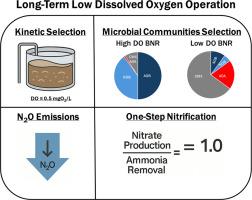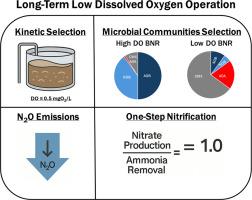通过动力学选择的低溶解氧硝化
IF 12.4
1区 环境科学与生态学
Q1 ENGINEERING, ENVIRONMENTAL
引用次数: 0
摘要
最近在废水处理方面的研究表明,通过实施低溶解氧(DO)操作,活性污泥厂在能源和碳利用方面可以更有效地运行,而不需要新的基础设施。本研究的目的是了解微生物群落如何适应长期低DO操作及其对硝化作用的影响。本研究综合了实验规模和全尺寸实验结果,以评估低DO操作对硝化速率、微生物群落结构和氧化亚氮(N2O)生成的影响。长期暴露在低溶解氧条件下导致硝化菌群落结构的转变,有利于comammox细菌(CMX)和氨氧化古细菌(AOA),而不是典型的氨氧化和亚硝酸盐氧化细菌(AOB, NOB)。在常规的高do系统中,硝态氮产率与氨氮去除率之比约为0.78,反映出NOB的生长速度低于AOB。然而,在研究的低DO设施中,该比率接近1.0,表明几乎所有去除的氨都直接转化为硝酸盐。这一发现有力地支持了CMX的优势,它可以在单个生物体中完成完全的氨氧化。在不同DO水平下运行的设施中,CMX丰度增加与硝酸盐产量增加之间的相关性是一致的。与来自高DO浓度植物的AOB和NOB相比,这些适应的群落表现出更高的氧亲和力。长期暴露于低DO浓度的生物质可能导致N2O排放减少,因为AOB和NOB的相对丰度较低,限制了通过羟胺氧化途径产生N2O和AOB的硝化物反硝化作用。本文章由计算机程序翻译,如有差异,请以英文原文为准。


Low dissolved oxygen nitrification through kinetic selection
Recent research in wastewater treatment demonstrates that activated sludge plants can be operated more efficiently in terms of energy and carbon utilization without the need for new infrastructure through the implementation of low dissolved oxygen (DO) operation. The aim of this study was to understand how microbial communities adapt to long-term low DO operations and the implications for nitrification. This study synthesized findings from bench-scale and full-scale experiments to assess the impact of low DO operation on nitrification rates, microbial community structure, and nitrous oxide (N2O) generation. Long-term exposure to low DO conditions led to a shift in the nitrifier community structure, favoring comammox bacteria (CMX) and, in some cases, ammonia-oxidizing archaea (AOA) over canonical ammonia-oxidizing and nitrite-oxidizing bacteria (AOB, NOB). In conventional high-DO systems, the ratio of nitrate production rate to ammonia removal rate is approximately 0.78, reflecting the lower growth rate of NOB compared to AOB. However, in the low DO facilities studied, this ratio approached 1.0, indicating that nearly all ammonia removed was directly converted to nitrate. This finding strongly supports the dominance of CMX which can perform complete ammonia oxidation in a single organism. The correlation between increased CMX abundance and increased nitrate production rates was consistent across facilities operating at different DO levels. These adapted communities demonstrated higher oxygen affinity compared to AOB and NOB from plants operated at high DO concentrations. Long-term exposure of biomass to low DO concentration may have resulted in a decrease in N2O emissions since there is a low relative abundance of AOB and NOB, limiting N2O production via the hydroxylamine oxidation pathway and nitrifier denitrification by AOB.
求助全文
通过发布文献求助,成功后即可免费获取论文全文。
去求助
来源期刊

Water Research
环境科学-工程:环境
CiteScore
20.80
自引率
9.40%
发文量
1307
审稿时长
38 days
期刊介绍:
Water Research, along with its open access companion journal Water Research X, serves as a platform for publishing original research papers covering various aspects of the science and technology related to the anthropogenic water cycle, water quality, and its management worldwide. The audience targeted by the journal comprises biologists, chemical engineers, chemists, civil engineers, environmental engineers, limnologists, and microbiologists. The scope of the journal include:
•Treatment processes for water and wastewaters (municipal, agricultural, industrial, and on-site treatment), including resource recovery and residuals management;
•Urban hydrology including sewer systems, stormwater management, and green infrastructure;
•Drinking water treatment and distribution;
•Potable and non-potable water reuse;
•Sanitation, public health, and risk assessment;
•Anaerobic digestion, solid and hazardous waste management, including source characterization and the effects and control of leachates and gaseous emissions;
•Contaminants (chemical, microbial, anthropogenic particles such as nanoparticles or microplastics) and related water quality sensing, monitoring, fate, and assessment;
•Anthropogenic impacts on inland, tidal, coastal and urban waters, focusing on surface and ground waters, and point and non-point sources of pollution;
•Environmental restoration, linked to surface water, groundwater and groundwater remediation;
•Analysis of the interfaces between sediments and water, and between water and atmosphere, focusing specifically on anthropogenic impacts;
•Mathematical modelling, systems analysis, machine learning, and beneficial use of big data related to the anthropogenic water cycle;
•Socio-economic, policy, and regulations studies.
 求助内容:
求助内容: 应助结果提醒方式:
应助结果提醒方式:


